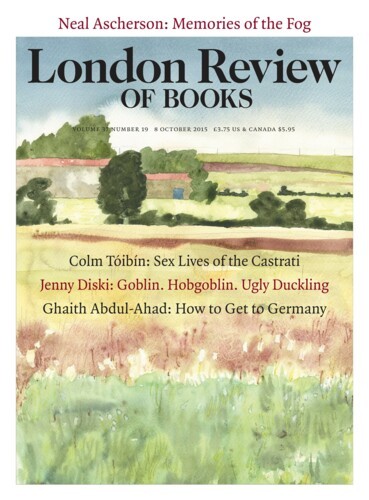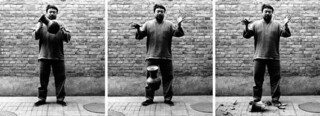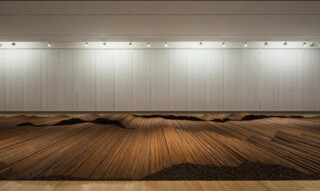Among the more modestly engaging works in Ai Weiwei’s spectacular and somewhat dispiriting exhibition at the Royal Academy (until 13 December) is a framed wire coathanger, stretched and bent to form a face in profile. It is recognisably the face of Marcel Duchamp, especially if you know his Self-Portrait in Profile, from 1957. Ai made Hanging Man in 1985, two years into a decade-long stay in New York, where he abandoned painting and fell under the spell of Andy Warhol, Jasper Johns and of course Duchamp: ‘The most, if not the only, influential figure in my so-called art practice’. Many of Ai’s early works are readymades of a kind, though they are frequently so freighted with symbolism, so stubbornly devoid of ambiguity – a tendency inflated in recent work – that the nimble-minded and evasive Duchamp would surely have baulked.
Although there’s a short volume of Weiwei-isms for sale in the RA gift shop, Ai is an artist who has practised very well the laconicism necessary to a mildly anti-art stance, and whose work is at its best when it refuses to explain its intentions. His photographic triptych Dropping a Han Dynasty Urn (1995) remains one of his most compelling works. The artist’s impassive expression doesn’t change as first he handles the urn lightly and then drops it. There are the attendant mysteries: is it really a Han dynasty artefact? And if so – why did he do it? He is asked about it still – in the catalogue for the RA show, for instance – and insists it was not a destructive act, but a gesture critical of the treatment of cultural heritage by the Chinese state. And there, precisely, is the problem for much of his art, whether unassumingly scaled or grandly imagined and engineered: Ai’s admirable if unenviable position as critic and victim of that state means the work is frequently reducible to a clear and courageous message. But can it be more than that?
He is not exactly literal-minded. A certain type of metaphor is the dominant mode in much, even most of the sculpture and the installations at the RA, a way of working that only infrequently – more often in the earlier work – attains the light, pointed quality of Duchamp’s readymades. The exhibition begins tastefully with Bed (2004), one of many pieces that include and partly conceal a map of China. Here the contours of the country are rendered in rich dark ironwood, fluted striations flowing low across the gallery floor. Like most of Ai’s works in wood, Bed was fashioned by traditional craftsmen, and contains numerous hidden joints and perfectly planed abutments between its sections: a knotty, hidden China beneath the surface. For all its scale and intricacy, Bed feels less complex than earlier wooden sculptures and amended readymades such as Table with Two Legs on the Wall (1997), which is in the next room. An elegant Qing dynasty table has been folded upwards in half so that two of its legs rest on the wall – a skilled and careful violence has been done to the antique object. It’s a beautifully contained but unnerving gesture, and didn’t need repeating 14 years later in a more elaborate three-legged version.
Although they are technically demanding, confecting new forms out of centuries-old furniture and portions of neglected temples, the wooden pieces have an affecting straightforwardness in the gallery. Elsewhere, Ai can seem remarkably glib in his use of historically weighted materials. The exhibition drags badly in the middle, a consequence in part of having a room devoted to works executed in white marble. Stone from the Dashiwo quarry, in which the artist has lately acquired a financial interest, was used to build the Forbidden City in the 15th century and, in the 1970s, Mao’s mausoleum. Ai’s installation Cao (2014) is a field of marble grass, containing a marble pushchair: a reference to his being spied on by the state while out strolling with his child in a park. The scene is attended by a surveillance camera, hefty camcorder and gas mask: all of these also in Dashiwo marble, and mounted on plinths. In common with the weakest of Ai’s work – consider another authentic Han vase, painted with the Coca-Cola logo – it is all too swiftly taken in and exhausted. Once you have spotted the irony there isn’t much more to think or to say.
Yet it is sometimes in the works conceived and carried out on the most audacious scale, with keen attention to the history and meaning of his materials, that Ai succeeds in making art that is moving, aesthetically complex and genuinely politically charged. Following the Sichuan earthquake of 2008, he was partly responsible for setting up a ‘citizens’ investigation’ into the deaths of the five thousand schoolchildren whose names had been withheld by the authorities. In Ai’s video footage of the wreckage, an engineer lights on the inferior and inappropriately handled building materials, the result of corrupt cost-cutting: the children stood no chance. Ai and others began to gather the names and personal details of the dead; they are recorded on two walls at the RA under the title Names of the Student Earthquake Victims Found by the Citizens’ Investigation.
At the same time he started buying up tonnes of twisted steel reinforcement bars from the ruined buildings, and had them straightened by hand at his studio. At the RA, between the gallery walls displaying the names of dead children, lies a neatly stacked expanse of rusted re-bar, six metres by twelve. It is by far the most resonant work in the exhibition, each precisely aligned rod representing a history of shameful neglect, the awful energy of the earthquake and the many hours of labour needed to hammer the steel back to its original state. In light of this piece, simply called Straight (2013), the choice of Bed as the exhibition’s opening work begins to make sense: ironwood and rufous steel resemble each other in colour and texture, and both works are maps of a country whose rulers would like to conceal the realities of material production.
Ai’s work is at its most resolved and convincing when the sheer bulk and presence of material takes over from easy allegories, when the physical or visual weight of stuff seems to exceed its duty as vehicle or metaphor. ‘I think in art you have to transform your primitive feelings into something that has clear language so that the story can be clearly told to another,’ he tells the RA’s artistic director, Tim Marlow, in the catalogue. But the last substantial work at the RA surely retains a good deal of ‘primitive feeling’ precisely in its brooding material and geometrical presence. S.A.C.R.E.D. (2013) is an installation of six rectangular boxes made of oxidised metal, each with its smooth surface interrupted twice by spy-holes and a domestic-looking door. The sculptural blocks are models, at half its actual size, of the cell in which Ai was held for 81 days in 2011. Inside each is a scene from his incarceration, uncannily re-created like stations of the cross or anecdotes from the life of Buddha. (The work was first shown at the Venice Biennale in 2013, in the Church of Sant’Antonin.) Though the scenes themselves are instructive and terrible – the prisoner watched over at all times by two guards as he eats, sleeps, showers and sits on the toilet – what stays in the mind is a field of blank metal stelae and the many others whose existence it implies.
Send Letters To:
The Editor
London Review of Books,
28 Little Russell Street
London, WC1A 2HN
letters@lrb.co.uk
Please include name, address, and a telephone number.



